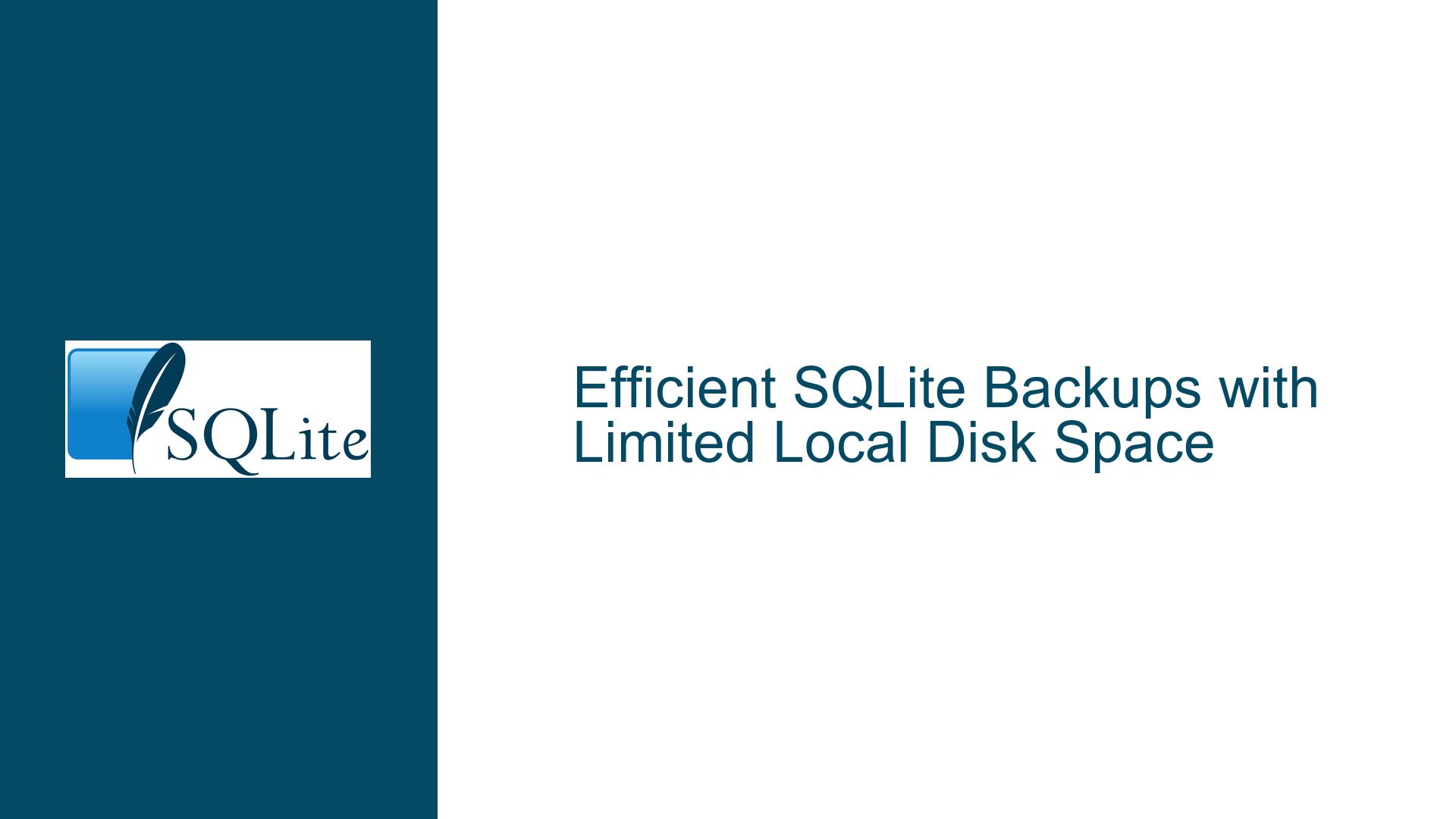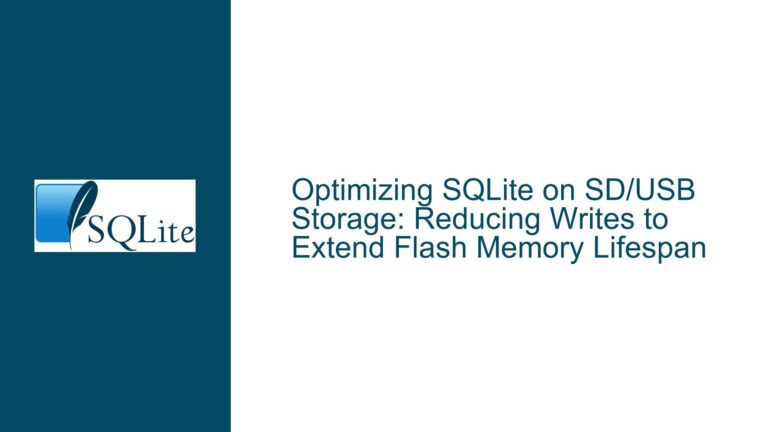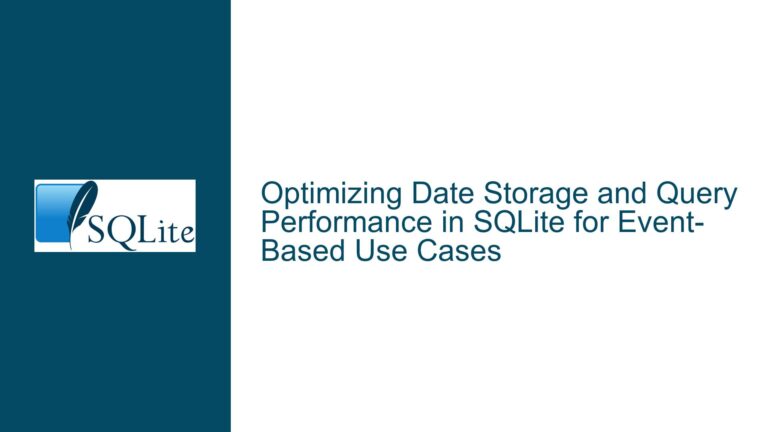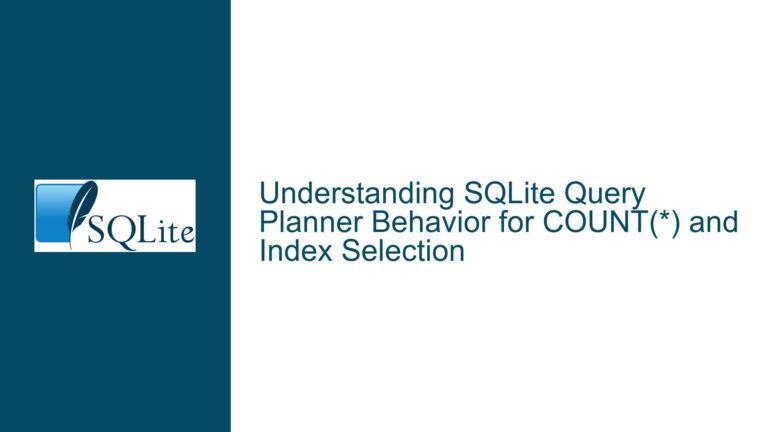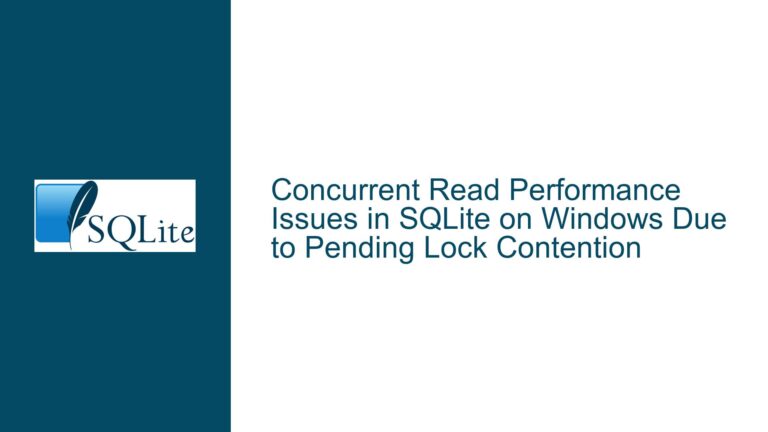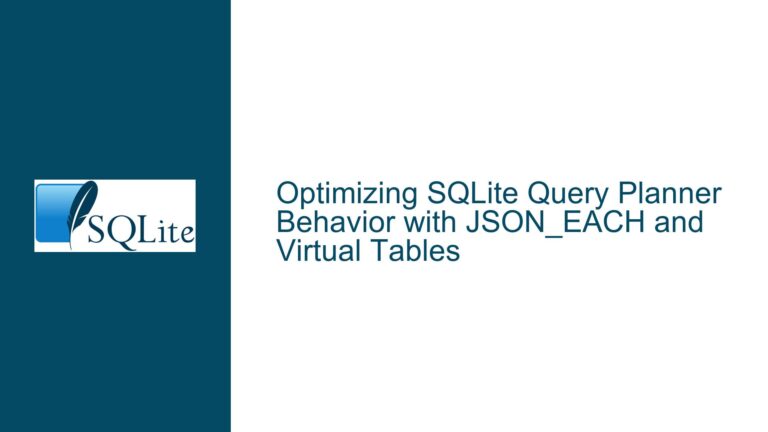Efficient SQLite Backups with Limited Local Disk Space
Understanding SQLite Backup Constraints in Space-Constrained Environments
The challenge of creating reliable SQLite database backups becomes acute when local disk space is insufficient to accommodate a full copy of the database file. Traditional backup methods like the SQLite Backup API and VACUUM INTO require writing a complete database duplicate to persistent storage, which may consume 80-100% of the original database’s size. This creates operational hurdles in containerized environments, edge devices, or cloud instances with strict storage quotas. The core dilemma revolves around maintaining data integrity while circumventing physical storage limitations through alternative backup strategies that don’t require local duplication.
Key constraints emerge from three directions:
- Destination Storage Requirements: Both
VACUUM INTOand Backup API operations demand contiguous write space equal to the database’s current size minus any potential vacuum shrinkage. - Concurrent Write Handling: Live databases may modify pages during backup operations, requiring transaction isolation.
- Network Infrastructure Limitations: Streaming backups introduce latency, authentication, and protocol-specific challenges that differ from local file operations.
These constraints compound when working with large databases (8GB+) on systems with minimal free space (e.g., 10GB total). A full backup could leave only 2GB free during the operation, risking system instability if temporary files or database growth occur mid-process. Understanding these pressure points guides the selection of appropriate backup strategies that balance reliability, resource consumption, and operational complexity.
Why Traditional Backup Methods Demand Full Destination Capacity
The SQLite Backup API and VACUUM INTO command appear deceptively simple but impose strict storage prerequisites due to their architectural implementation.
Backup API Mechanics:
SQLite’s online backup mechanism initializes by querying the database page count, then sequentially copies each page to the destination. While this occurs, the source database remains in WAL (Write-Ahead Logging) mode, allowing concurrent reads and writes. The destination file must be created with sufficient space to hold all pages at the moment the backup starts. Even if pages are later freed during vacuuming, the initial allocation requires maximum potential size.
VACUUM INTO Behavior:
The VACUUM INTO 'new.db' command rebuilds the database by creating a temporary copy, compacting free pages, then atomically replacing the target file. This process requires:
- Write permissions to the destination directory
- Storage equal to the post-vacuum size of the database
- A stable filesystem throughout the operation
Both methods rely on POSIX-compliant file operations that assume direct access to block storage. They cannot natively stream data to network endpoints or sequential devices without filesystem abstraction. This limitation stems from SQLite’s design as an embedded database engine rather than a client-server system.
Storage Allocation Nuances:
File systems allocate space in blocks (typically 4KB). When creating a new database file, SQLite preallocates metadata pages and schema definitions. The VACUUM command may reduce file size by eliminating fragmented free pages but cannot guarantee a specific output size. In scenarios with many small deletions, vacuuming might only marginally reduce the file footprint.
Containerized Environment Complications:
Docker and similar container runtimes often mount volumes with fixed size constraints. Even if network-attached storage is available, binding it requires explicit volume configuration. Many managed container services restrict volume attachments to prevent resource contention, forcing backups to occur within the container’s ephemeral filesystem.
Network-Centric Backup Strategies for Space-Constrained Systems
SQL Dump Streaming via SSH
The .dump command converts the entire database into SQL statements, which can be piped directly to remote systems without local storage.
Implementation Steps:
- Initiate an SSH Connection with key-based authentication to avoid password prompts in automated workflows:
ssh user@backup-server "cat > /backups/$(date +%Y%m%d).sql" < <(sqlite3 production.db .dump) - Compress During Transfer to reduce network bandwidth and storage:
sqlite3 production.db .dump | gzip -c | ssh user@backup-server "gunzip -c > /backups/$(date +%Y%m%d).sql" - Maintain Transaction Consistency by wrapping the dump in a transaction:
sqlite3 production.db "BEGIN IMMEDIATE; .dump COMMIT;" | ssh ...
Advantages:
- Near-zero local storage requirements (only pipe buffers)
- Compatible with any SSH-capable backup target
- Human-readable output for partial recovery
Caveats:
- Prolonged runtime for large databases due to single-threaded serialization
- Schema and data reconstructed on import, which may differ from binary copies
- Requires write locks during the dump if using
BEGIN IMMEDIATE
Network Filesystem Mounts for Direct Backup
Mounting a remote filesystem via NFS/SMB allows using traditional backup methods while offloading storage.
NFS Configuration Example:
- On the backup server, export a directory via NFS:
# /etc/exports /backups 192.168.1.100(rw,sync,no_subtree_check) - On the SQLite host, mount the NFS share:
mkdir -p /mnt/backups mount -t nfs backup-server:/backups /mnt/backups - Execute
VACUUM INTOor Backup API targeting the mounted directory:sqlite3 production.db "VACUUM INTO '/mnt/backups/$(date +%Y%m%d).db'"
Container-Specific Considerations:
- Docker requires
--cap-add SYS_ADMINto mount NFS inside containers - Kubernetes pods can use NFS persistent volumes
- Mount latency may impact backup speed compared to local storage
Litestream Continuous Replication
Litestream operates as a background process that streams WAL updates to cloud storage, providing point-in-time recovery without full backups.
Deployment Workflow:
- Install Litestream on the SQLite host:
curl -LO https://github.com/benbjohnson/litestream/releases/download/v0.3.9/litestream-v0.3.9-linux-amd64.tar.gz tar xvf litestream-v0.3.9-linux-amd64.tar.gz sudo mv litestream /usr/local/bin/ - Configure Replication to S3-compatible storage:
# /etc/litestream.yml dbs: - path: /var/lib/production.db replicas: - url: s3://backup-bucket/production.db - Run as a Service:
litestream replicate -config /etc/litestream.yml
Operational Benefits:
- Incremental backups at configurable intervals (default 1 minute)
- No local storage beyond the primary database and WAL
- Direct database restoration via
litestream restore
Restoration Process:
litestream restore -o restored.db s3://backup-bucket/production.db
sqlite3 restored.db "PRAGMA integrity_check"
Hybrid Approach: Delta Backups with RSync
For environments with infrequent writes, RSync can minimize network transfer by copying only modified database pages.
Procedure:
- Initial Full Backup:
rsync -avz production.db user@backup-server:/backups/full.db - Incremental Updates:
rsync -avz --link-dest=/backups/full.db production.db user@backup-server:/backups/incr/$(date +%s).db
SQLite-Specific Optimizations:
- Use
PRAGMA wal_checkpoint(TRUNCATE)before RSync to minimize WAL size - Pair with
SELECT COUNT(*) FROM sqlite_schema;to force schema validation
SQLite Archive Mode for Binary Portability
The .archive command enables creating and restoring compressed database archives.
Creating a Remote Archive:
sqlite3 production.db ".archive --output | ssh user@backup-server 'cat > backup.zip'"
Restoring from Archive:
ssh user@backup-server "cat backup.zip" | sqlite3 restored.db ".archive --input"
Compression Efficiency:
- SQLite’s internal BLOB storage often compresses by 60-70% with ZIP
- Avoids parser overhead compared to SQL dumps
Mitigating Backup-Induced Lock Contention
All backup methods risk blocking application writes if not properly isolated.
Concurrency Strategies:
- WAL Mode Enforcement:
PRAGMA journal_mode=WAL; - Timeout Configuration:
PRAGMA busy_timeout=5000; -- 5-second retry - Read-Uncommitted Queries:
PRAGMA read_uncommitted=1;
Monitoring Lock States:
sqlite3 production.db "SELECT * FROM pragma_lock_status;"
Operational Validation and Integrity Checking
Post-backup validation is critical when using space-constrained methods.
Binary Backup Checks:
sqlite3 backup.db "PRAGMA quick_check;"
SQL Dump Validation:
ssh backup-server "sqlite3 test.db < /backups/latest.sql; sqlite3 test.db 'PRAGMA integrity_check;'"
Litestream Health Monitoring:
litestream databases
litestream generations s3://backup-bucket/production.db
Automated Alerting:
Integrate checks into monitoring systems (Prometheus, Nagios) with metrics on:
- Backup completion timestamps
- Integrity check results
- Storage consumption growth rates
Capacity Planning and Growth Projection
Anticipate future storage needs using SQLite’s internal statistics.
Space Utilization Analysis:
SELECT page_count * page_size AS size FROM pragma_page_count, pragma_page_size;
Schema Fragmentation Assessment:
SELECT name, (pgsize - usable_region) AS fragmentation
FROM sqlite_dbstat
WHERE aggregate=TRUE;
Growth Trend Forecasting:
sqlite3 production.db "SELECT changes() FROM (SELECT total_changes() AS changes);"
Regulatory and Security Considerations
Encrypted Backups:
Use SQLite’s Encryption Extension (SEE) or external tools:
sqlite3 production.db .dump | openssl aes-256-cbc -salt -out backup.sql.enc
Access Control:
- Restrict NFS exports to backup-specific IPs
- Use SSH certificates instead of passwords
- Enable S3 bucket versioning and object lock
Audit Logging:
sqlite3 production.db "CREATE TABLE backup_audit(timestamp INT, method TEXT, dest TEXT);"
# After each backup:
sqlite3 production.db "INSERT INTO backup_audit VALUES(strftime('%s','now'), 'SSH dump', 'backup-server');"
Performance Tuning for Network Backups
SSH Compression Tuning:
- Enable multiplexing in
~/.ssh/config:Host backup-server Compression yes CompressionLevel 9 ControlMaster auto ControlPath ~/.ssh/control-%r@%h:%p
Parallel Streams with GNU Parallel:
sqlite3 production.db .dump | parallel --pipe --block 10M "gzip -c | ssh ..."
Network Buffer Optimization:
sysctl -w net.core.rmem_max=16777216
sysctl -w net.core.wmem_max=16777216
Conclusion and Strategic Recommendations
Space-constrained SQLite backups demand a layered approach:
- Immediate Solution: Implement SSH-based SQL dumps with compression for rapid deployment.
- Medium-Term Strategy: Configure Litestream for continuous protection with minimal overhead.
- Long-Term Architecture: Integrate network-mounted storage with periodic
VACUUM INTOoperations.
Regularly validate backup integrity through automated checks and monitor storage growth patterns to preempt capacity crises. Combine logical dumps (for portability) with binary backups (for speed) to create a resilient hybrid strategy tailored to your operational constraints.
